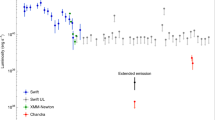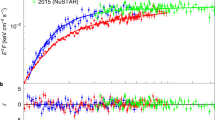Abstract
The X-ray pulsar PSR0540–693 was discovered in the Large Magellanic Cloud (LMC) supernova remnant, 0540–69.3, by Seward, Harnden and Helfand1, as a pulse, with repetition period ∼50 ms, in Einstein Observatory data. Previously, Clark et al.2 had noted that this remnant resembles the Crab Nebula because of the X-ray power law spectrum and suggested that the nebular emission was synchrotron radiation powered by a central pulsar. After the announcement of X-ray pulsed emission, Chanan et al.3 measured the broad optical band properties of the nebula and found evidence for synchrotron emission. They reported that the 4.5-arc s continuum emission remnant has only a tenth of the luminosity of the Crab Nebula. We have now detected pulsed optical emission for the X-ray pulsar, having a time-averaged magnitude of ∼22.7.
This is a preview of subscription content, access via your institution
Access options
Subscribe to this journal
Receive 51 print issues and online access
$199.00 per year
only $3.90 per issue
Buy this article
- Purchase on Springer Link
- Instant access to full article PDF
Prices may be subject to local taxes which are calculated during checkout
Similar content being viewed by others
References
Seward, F. D., Harnden, F. R. & Helfand, D. J. Astrophys. J. lett. (in the press).
Clark, D. H. et al. Astrophys. J. 255, 440–446 (1982).
Chanan, G. A., Helfand, D. J. & Reynolds, S. P. Astrophys. J. Lett. (in the press).
Middleditch, J. et al. Nature 306, 163–164 (1983).
Middleditch, J., Kristian, J. Astrophys. J. 279, 157–161 (1984).
Miller, J. S. Astrophys. J. Lett. 180, L83–L87 (1973).
Savage, B. D., Fitzpatrick, E. L., Cassinelli, J. P. & Ebbets, D. C. Astrophys. J. 273, 597–623 (1983).
Kristian, J., Visvananthan, N., Westphal, J. A. & Snellen, G. H. Astrophys. J. 162, 475–483 (1970).
Manchester, R. N. & Taylor, J. H. Pulsars (Freeman, San Francisco, 1977).
Pacini, F. Astrophys. J. Lett. 163, L17–L20 (1971).
Pacini, F. & Salvati, M. Astrophys. J. 274, 369–371 (1983).
Manchester, R. N. Proc. Workshop on Birth and Evolution of Neutron Stars No. 8 (eds Reynolds, S. P. & Stinebring, D. R.) (National Radio Astronomy Observatory Publications, Greenbank, West Virginia, 1984).
Seward, F. D. Proc. Workshop on the Crab Nebula and Related Supernova Remnants (eds Kafatos, M. C. & Henry, R. C. B.) (Cambridge University Press, 1984).
Downs, G. S. Astrophys. J. 249, 687–697 (1981).
Groth, E. J. Astrophys. J. Suppl. 29, 453–465 (1975).
Author information
Authors and Affiliations
Rights and permissions
About this article
Cite this article
Middleditch, J., Pennypacker, C. Optical pulsations in the Large Magellanic Cloud remnant 0540–69.3. Nature 313, 659–661 (1985). https://doi.org/10.1038/313659a0
Received:
Accepted:
Issue Date:
DOI: https://doi.org/10.1038/313659a0
This article is cited by
-
Identification of the central compact object in the young supernova remnant 1E 0102.2–7219
Nature Astronomy (2018)
-
Concept of High Speed Astronomical Instrumentation Based on Visible Light Photon Counters
Experimental Astronomy (2004)
-
Evolution of massive binary stars in the LMC and its implications for radio pulsar population
Journal of Astrophysics and Astronomy (1992)
Comments
By submitting a comment you agree to abide by our Terms and Community Guidelines. If you find something abusive or that does not comply with our terms or guidelines please flag it as inappropriate.



